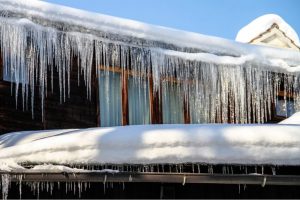Ice Dam Removal & Prevention Tips
Feb 3, 2023

Anyone who lives in a part of the world that sees cold weather knows that with snow and ice, there will always be some form of trouble. It’s freezing outside, you have to wear several thick layers and you have to dig your car out of the snow. That’s just the beginning of the list. You also have to keep your house in mind. Ice dams, a burden to many homeowners, can form and damage your roof and home if you don’t do anything about them.
What is an Ice Dam?
An ice dam is the ridge of ice that you’ll see on the edge of a roof. These icicles might be pretty to look at, but it’s a sight that should worry homeowners. That’s because ice dams disrupt the process of melting snow to draining properly. When the water is backed up behind the ice dam, it can leak into the home and cause serious damage to areas such as the ceilings, walls and floors. Homeowners may see ice dams on their roofs after a heavy snowfall or freezing temperatures.
What Causes Ice Dams?
The formation of an ice dam begins when collective heat escapes and warms the roof. The snow melts on the warm roof and then freezes on the cold eaves. The ice accumulates along the eaves and forms a dam. Meltwater from the warm roof backs up behind the dam and can flow under the shingles and into the house.
The Signs of an Ice Dam
Maybe you’re not sure if you’ve got one on your roof. These are the tell-tale signs that you may have an ice dam:
- Ice formation behind the gutters
- Icicles of all shapes and sizes hanging on the edge of your roof
- Water or ice formation inside or outside your window frames
- Water or ice formation on the exterior wall of your home
How to Prevent Them from Forming
In some newer and modern homes, there are waterproof membranes underneath the shingles to help prevent leaks from seeping in. That’s not the case for older homes, though—since they usually don’t have proper insulation, it’s much more common to see ice dams on older homes.
First things first, you’ll have to make sure that your roof stays cold. When you do this, the snow on the roof melts away without forming high levels of melt water. Look into insulating your attic to prevent the formation of ice dams. Seal areas where warm air can escape to the attic. Common air leaks come from chimneys, gaps in drywall or unblocked walls. The attic should also be ventilated so that cold air comes through and allows warm attic air to escape quickly.
Don’t forget to remove snow from your roof. Use a roof rake to clear off the snow from the roof’s edge. As every roof and home is different, the amount of ice and snow a roof can handle varies. How much a roof can withstand depends on how old the home is and on the roof’s type. If you see that over a foot of snow and ice is sitting on your roof, it’s a good idea to look into ice dam and snow removal. This could be a dangerous task, especially if you haven’t dealt with this problem before. It’s never a bad idea to research and contact professional roofing contractors to take care of this issue.
What to do if you Already Have an Ice Dam
You might be tempted to take shortcuts or let your frustration out by hacking the ice away with an axe or hammer. Take a deep breath and put down the tools. There are safer methods to ensure that you and your roof stay intact.
A roofing company can steam the ice and snow to melt it away without damaging your roof and shingles. They’ll use steamers which produce steam that reaches or exceeds temperatures of 121 °C. Before turning the steamer on, they’ll clear off the snow to find the ice dam to properly remove it. An ice dam and snow removal job can take anywhere between 2-4 hours to complete—one of the main factors of that range depends on how severe the issue is.
The problems that come from ice dams can cause a huge headache, but now you know how to prevent them from happening in the first place. Prevention and maintenance is the safest bet when it comes to making sure you don’t experience these issues. And if you’re wondering how else you could avoid these problems altogether—just pack up and move somewhere hot!





